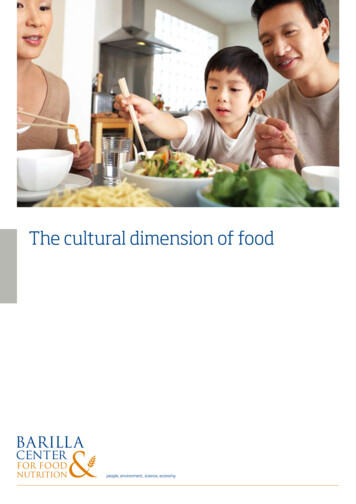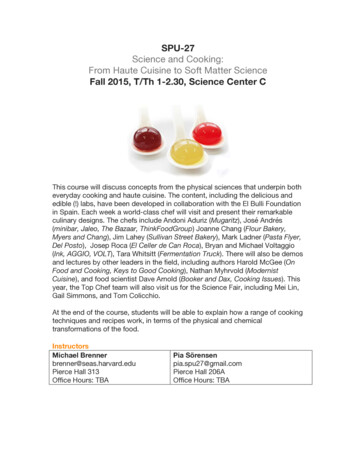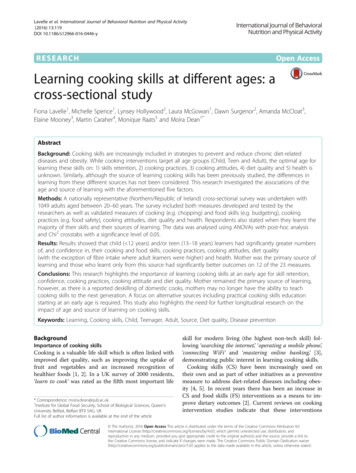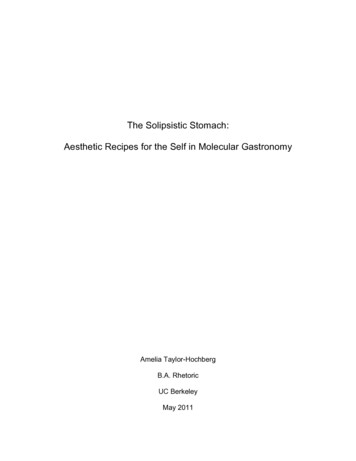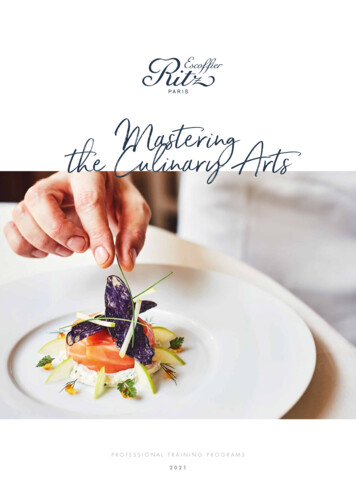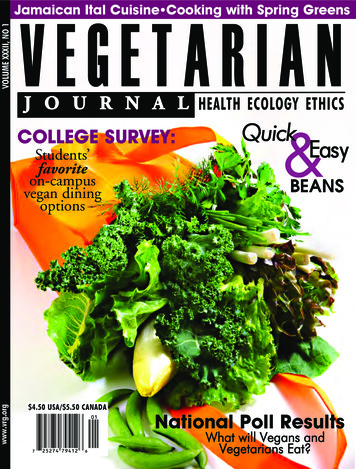
Transcription
VOLUME XXXII, NO 1www.vrg.orgVEGETARIANJamaican Ital Cuisine·Cooking with Spring GreensJ O U R N A L HEALTH ECOLOGY ETHICSCOLLEGE SURVEY:Students’favoriteon-campusvegan diningoptions 4.50 USA/ 5.50 CANADA&QuickEasyBEANSNational Poll ResultsWhat will Vegans andVegetarians Eat?
NUTRITION HOTLINEREED MANGELS, PhD, RDThis issue’s NutritionHotline addresses foodsafety guidelines tofollow when hosting avegan potluck.2QUESTION: “I’m planning to host avegan potluck and wondered if therewere things that I should be awareof in terms of food safety.”G.H., via e-mailANSWER: Great thinking – everyyear millions of people in theUnited States get sick from contaminated food. While we oftenthink of chicken, mayonnaise,and other animal products asprime causes of food poisoning,bacteria also multiply in plantbased dishes. A few simple practices will help to keep your guestshealthy.As you prepare food for thepotluck, be sure to wash yourhands frequently, especially if youare going back and forth betweenfood prep and other chores. Ifyou’re making a salad, or cuttingup fruits and vegetables, wash thefruits and vegetables before cutting them. This helps to keep bacteria on the surface from beingtransferred to the cut part of thefruit on the knife used for cutting.As you set up for the potluck,make sure you have plenty ofserving utensils. Using a utensilfor each dish avoids cross-contamination and reduces the risk ofsomeone using their (unwashed)hands to pick through a bowl orplate of food. Serving dips andsalsas with a serving spoon alsodiscourages double-dipping.Provide Post-its or index cardsso your guests can list the ingredients in their dishes. This simplestep is a huge help to people withfood allergies or sensitivities. Ifyou have guests with severe allergies, consider having one servingtable that only has foods thatdon’t contain the allergen – nonuts, for example. This reducesthe risk of the serving spoon fromthe peanut noodles accidentallyending up in the nut-free ricesalad.Encourage your guests toreheat food as necessary whenthey arrive at the potluck. Foodsthat are to be served hot shouldbe reheated rapidly to a temperature of 165 degrees or higher.Keep foods hot (at least 140degrees) on the serving table byusing slow cookers or chafingdishes. If you plan to socializebefore eating, keep perishablefoods like dips, salads, and spreadsin the refrigerator until you’reready to eat.Keep track of time; foodsshould not sit at room temperature for more than two hours,including transport time. If youcan’t refrigerate foods, discardanything perishable that has beenout for more than two hours.Foods like bread and chips do notneed to be discarded.Of course, you can’t controlthe food preparation practices ofpeople attending your potluck,but the steps above will help toreduce the risks of food poisoningor allergic reactions for yourguests.Vol. 32, Issue One 2013 VEGETARIAN JOURNAL
MANAGING EDITOR: Debra WassermanSENIOR EDITOR: Samantha GendlerEDITORS: Carole Hamlin,Jane Michalek, Charles StahlerNUTRITION EDITOR: Reed Mangels, PhD, RDNUTRITIONAL ANALYSES: Suzanne HengenCOVER PHOTO AND STYLING: Linda Long,Alessandra FeliceVRG VOLUNTEER COORDINATORAND CATALOG MANAGER: Mary HerbransonWEB DEVELOPMENT/RESEARCH: John CunninghamRESEARCH DIRECTOR: Jeanne YacoubouRESTAURANT GUIDE/MEMBERSHIP: Sonja HelmanVEGETARIAN RESOURCE GROUP ADVISORS:Arnold Alper, MD; Nancy Berkoff, EdD, RD;Catherine Conway, MS, RD; Jim Dunn;Heather Gorn, MPhil; Suzanne Havala Hobbs,DrPH, MS, RD; Enette Larson-Meyer, PhD, RD;Reed Mangels, PhD, RD; Jerome Marcus, MD;Virginia Messina, MPH, RD; Mark Rifkin, MS, RD;Brad Scott, MBA; Eric Sharer, MPH, RD, LDN;Wayne Smeltz, PhDCOPYRIGHT 2013 BY THE VEGETARIANRESOURCE GROUP, INCORPORATEDPRINTED IN THE UNITED STATES OF AMERICA.The Vegetarian Journal (ISSN 0885-7636) ispublished quarterly. The contents of VegetarianJournal and our other publications, including webinformation, are not intended to provide personalmedical advice. Medical advice should be obtainedfrom a qualified health professional. We oftendepend on company statements for productand ingredient information. It is impossible to be100% sure about a statement, info can change,people have different views, and mistakes can bemade. Please use your own best judgement aboutwhether a product is suitable for you. To be sure,do further research or confirmation on your own.SUBMISSIONS: We do not accept unsolicitedmanuscripts. Please send a query letter first.ADVERTISING: Vegetarian Journal does not acceptpaid advertising. We do review vegan products.E-MAIL: Contact The VRG at vrg@vrg.org.The VRG’s website is www.vrg.org .CHANGE OF ADDRESS: Please send changeof address to P.O. Box 1463, Baltimore, MD21203. You may also e-mail a changeof address to vrg@vrg.org.FOR INFORMATION, CALL (410) 366-VEGE.Also, if you do not want your name tradedto other organizations, please let us know.www.vrg.orgFEATURES6 · Cooking with Early Spring GreensIt’s easy being green with Chef Nancy Berkoff.14 · What will Vegans and Vegetarians Eat?See the results of The VRG’s national poll!18 · Jamaican Ital CuisineSaba Igbe shares vegan dishes from Ashanti Oasis Vegetarian Restaurant.24 · College SurveyWhat are students’ favorite on-campus vegan dining options?26 · A Vegan in ChinaAfter spending two semesters in China, former VRG intern YasminRadbod learned what it takes to be a vegan in China.DEPARTMENTSNutrition Hotline2Food safety guidelines you should follow when holding a vegan potluck mealNote from the Coordinators4Letters to the Editors5Vegan Cooking Tips10Quick and Easy Beans: Dishes to Warm You from the Inside this Winter,by Chef Nancy Berkoff, RD, EdD, CCEScientific Update12Notes from The VRG Scientific Department17Veggie Bits22Vegetarian Resource Group’s 2012 Essay Contest Winner30Seven-year-old Colin Vineberg has been vegetarian since he was born.Book Reviews31Catalog33Vegetarian Action35Marla Rose: An Extraordinary Vegan Activist in Chicago, Illinois,by Aileen McGrawVRG Outreach BoothsBack CoverVegetarian Journal is one project of The Vegetarian Resource Group. We are a nonprofit thateducates the public about veganism/vegetarianism and the interrelated issues of health, nutrition,ecology, ethics, and world hunger. To join VRG and receive Vegetarian Journal in the USA,send 25 to The Vegetarian Resource Group, P.O. Box 1463, Baltimore, MD 21203, or goto www.vrg.org/donate . Additional don ations support our outreach and research.VEGETARIAN JOURNAL Vol. 32, Issue One 20133
NOTEFROM THECOORDINATORSA HEARTY VEGAN THANK YOU!We give a happy welcome to our new editor Samantha Gendler and asad goodbye to our now former editor Keryl Cryer who left after adecade of service. Thank you to both Keryl and Samantha for makingthe transition as smooth as possible. Though the change included the usual learning curve, this was less overwhelming than 10 years ago when our former editorleft and Debra was operating with no sleep keeping the Vegetarian Journal ontime while tending to a young child and figuring out what to do with all theunknowns after 9/11 and the economic downturn. At that time, for a few yearswe noticed that many vegetarian and animal rights groups/volunteers became lowkey. Today, we’re happy to observe that veggie festivals and outreach again arebooming all over the country.Kudos to VRG’s Volunteer Coordinator Mary Herbranson, who realizedduring a single week she had our high school intern Soren packing for outreachbooths at 12 events. Thank you to all our interns, volunteers, and donors aroundthe country who allow us to be at venues from professional conferences and vegetarian festivals to street fairs and presentations in prisons and schools. And it wascool that after an intern roped her mother into helping at one of our communityoutreach booths, that mom, who had so much fun, decided to organize a two-dayvegetarian booth at a county fair in a relatively conservative area of the state. Ifyou would like to help with outreach anywhere in the country, please pop Mary anote at vrg@vrg.org or call (410) 366-8343. For those of you living in Maryland,volunteering in the office to help send out all these materials can make a hugedifference. And of course financial contributions and bequests are greatly appreciated so we can keep up with all the outreach opportunities.VRG had an outreach booth at Natural Products Expo. It was satisfyinganswering questions from exporters of vegan goods from Colombia, BurkinaFaso, and elsewhere. We were glad we could point a New York City school foodservice looking for sources of vegan cheese without nuts or coconut in the rightdirection. To help us encourage and answer many of the questions we receivefrom companies who want to market vegan products, we’ve conducted numerouspolls over the years. For example, see our new poll results starting on page 14.At the Natural Products Expo East, there was a host of new vegan productsbeing displayed from kale chips and coconut ice cream to vegan scallops, veganchocolate crunch bars and hearty vegan lentil dishes. To learn about some ofthese new items, look for reviews on our blog at www.vrg.org, as well as in theVeggie Bits column of this issue on pages 22-23.Debra Wasserman & Charles StahlerCoordinators of The Vegetarian Resource Group4Vol. 32, Issue One 2013 VEGETARIAN JOURNAL
VRG’s MEMORIALAND HONORARYGIFT PROGRAMHow often have you wanted tomake a gift in honor of a lovedone or friend but weren’t surewhich charities are vegetarianfriendly, pro-environmental, orpro-animal rights? Please remember The Vegetarian ResourceGroup. You can make a gift inmemory of a loved one or as aliving tribute to honor someoneyou care about on a special occasion, such as a wedding or birth.We’ll send an acknowledgementto you and to the recipient(s) youchoose. Your gift will supporteducational outreach programsand help promote vegetarianism.Memorials & Honorary GiftsIn memory of:In honor of:Please send acknowledgement to:Name:Address:My name and address:Name:Address:lettersVegans Should NotRide HorsesI just read “Non-Leather SaddlesNow Available” in Volume 31 ofVegetarian Journal. The author ishappily sharing with the readersthat we vegans now have a nonleather alternative to leather saddles. To me, that seems to makeabout as much sense as announcing in a Jewish magazine that wefinally have an organic, naturallyfed, humanely treated pig we caneat!Vegans, by definition, not onlyrestrict their diets of all animalbased foods, but avoid using otheranimal products as much as possible. And why do we go the extramile beyond simply not eatinganimal-based products? Becausewe don’t wish to harm animals inany way. Wearing leather shoes isbeing a party to animal cruelty.So, does it make sense toenslave a horse and then, at thesame time, think that you’re beingkind to the cow to not use its skinto make a saddle?In my experience, horses arevery sentient beings. I’ll never forget the one year that my wife andI lived adjacent to a corral wheretwo horses lived: a male and afemale, companions of each other.Make checks payable to The VegetarianResource Group and mail to P.O. Box1463, Baltimore, MD 21203.Thank you so much to Alan A. Polster forconverting VRG information into HTML for ourwebsite: www.vrg.orgSpecial thanks to the numerous interns andvolunteers we’ve had over the past 6 months inthe VRG office! We greatly appreciate all yourhelp doing research and outreach.Thanks to TheVegetarianSite.com for theirgenerous donation!The male was, on a fairly regularbasis, taken out for one reason oranother, but the female was left inthe corral. Inevitably, the femalewould shriek at the top of herlungs as her companion was takenaway. Of course, the male wouldeventually be returned to the corral. Nonetheless, when he wastaken away again, the result wasthe same: the female expressed herdispleasure in no uncertain terms.Do horses like to be enslaved?All you have to do to answer thisquestion is watch a horse being“broken in.” They buck andthrow the riders until their fight isgone. Eventually they give up andthe human becomes their master.Not only are the horses forced todo work, but they are not free.From time to time, their humanmasters must use aversive stimulito control their behavior (spurs,whips, etc.).To really show kindness toanimals, I’d suggest stop ridinghorses. Period! Micah L., via e-mailNote: Readers who are interested ineliminating the use of leather canutilize The Vegetarian ResourceGroup’s updated Vegan Guide toLeather Alternatives at: http://www.vrg.org/nutshell/leather.phpLetters to the Editors can be sent to: Vegetarian Journal, P.O. Box 1463,Baltimore, MD 21203. You may also e-mail letters to vrg@vrg.org.Coming in the Next Issue:FILIPINO CUISINEPlus: Cooking with Fresh Herbs, Quick Breakfasts,Using a Co-Packer to Produce Vegan Food, and more!VEGETARIAN JOURNAL Vol. 32, Issue One 20135
Cooking with.EarlyspringBy Chef Nancy Berkoff, RD, EdDCabbage, cilantro, parsley, Swiss chard, green peppers, chilies, leeks, scallions and chives, snow peas,petit pois (young green peas), spinach, kale, collards,mustard and beet greens, romaine, and endive are someof the greenery we can use to brighten our springmenu! It certainly is easy eatin’ green.FENNEL FLAVORSYou can call it Florence fennel, you can call it sweetanise, you can even call it finocchio; however youname it, spring is the time to enjoy fennel. Learn torecognize fennel by its white Disney-esque celery stalk,tapering off to skinny (like the diameter of your indexfinger) stalks and ending with feathery leaves, reminiscent in shape of fresh dill. Fennel has a mild licoricearoma and flavor. Used correctly, it is absolutely intoxicating.Fennel can be eaten raw. Just de-string the bulband the stalks with a vegetable peeler and crunchon it as you would celery. Or, buy a baggedsalad, slice some fresh fennel, and tossin some walnuts, and you have anupscale salad with no fuss.When we’re talking fresh beans, we’re talking aboutall the varieties of green beans, wax beans and freshflageolet, lima, butter beans (baby lima beans), andblack-eyed peas harvested in the spring. Think thatlima beans are too starchy and grainy for you? Try toround up some fresh limas or butter beans before theyare dried (or frozen or canned.) You’ll find they aresweet, soft, and oh-so-good.Fresh green beans vary in color, texture and size,depending on the variety of seed used and growingregion. There are the snooty haricots verts, Greyhoundslender green beans used in salade Niçoise, and stockysnap beans. Green beans can be purple, striped, or dotted with red. Wax beans can be pale beige to sunny yellow. Both green and wax beans can be eaten uncookedas a snack or tossed into any kind of salad. They canalso be steamed or grilled and served as a side dish.FRESH BEANS FOR SPRINGThink you need a vitamin pill to getvitamin C, vitamin A, folicacid, thiamin, iron,potassium, magnesium,and calcium? You don’t! Youjust need a plate of freshbeans. Over 7000 years ago,civilizations in Mexico and Peruwere cultivating beans. Eatingbeans is a good recommendation thathas stood the test of time.6Vol. 32, Issue One 2013 VEGETARIAN JOURNAL
COOKIN’ GREEN CABBAGEFresh tender heads of green spring cabbage are a versatile ingredient for your spring menu. Separate leavesfor wrapping savory mixtures of cornbread or wholewheat stuffing, or stuff with rice, chopped veggies andnuts. Try shredding green cabbage for use in stir-fries,soups, and stews.Green cabbage holds up just fine to light steamingand a toss with soy sauce and sesame seeds. Bok choy(Asian cabbage with a sweet-tasting stalk and leavesthat resemble spinach) and Napa cabbage (a pale greencabbage that resembles Romaine lettuce), are alsoagreeable to being steamed or tossed with seasoning orsalad dressings of your choice.Cabbage is known for its prominence in Irish dishes, and the traditional Irish dish, colcannon, can easilygo vegan. Mix sautéed onions and cabbage intomashed potatoes and serve as is, or shape into potatocakes coated with breadcrumbs and bake. The cabbageadds texture and nutrients to the mashed potatoes.The addition of silken tofu or Ener-G egg substituteto colcannon brings you to a colcannon croquette,once formed into triangles and baked in the oven.If you’re in a time crunch, prepare colcannon withpre-shredded bagged cabbage and instant veganmashed potatoes.HUNTING THE A-LUSIVE ASPARAGUSAsparagus can be found as a green, purple, or whitevegetable. Green asparagus usually has the most flavorand is the most robust of all three. Purple asparaguslooks pretty when raw, but will convert to mostlygreen when cooked. Asparagus does not like to sitaround for very long. If you plan to keep your asparagus in the refrigerator for more than a day, place theasparagus in a clean vase or glass, fill with water, andstore as an asparagus “bouquet” in the back of therefrigerator, where it is coldest.Asparagus doesn’t benefit from a great deal of handling. For perfectly cooked asparagus, fill a frying panwith water and bring it to a boil. Trim a small amountof the stem ends, wash, and plunge into the boilingwater. Turn constantly, and in about three minutesyou’ll have perfectly cooked asparagus. Remove fromthe water, rinse quickly under cold water, or place inan ice bath (equal parts cold water and ice) until theheat is removed. Serve immediately as a warm vegetable, or chill in the refrigerator to be used as a coldsnack or salad ingredientTo create a cream of asparagus soup, you’ll want topeel the asparagus first, just like you peel a carrot.VEGETARIAN JOURNAL Vol. 32, Issue One 2013ThinkgreennutritionThinkHere are some nutrition notes to use as “selling” points for a 4-ounce serving of greenspring veggies:Romaine lettuce has 2600 IU of vitamin A,24 mg of vitamin C, and 36 mg of calcium(as opposed to iceberg lettuce, which has 330IU of A, 4 mg of C and 19 mg of calcium.)Romaine isn’t just for Caesar salad; try braising it in a small amount of veggie stock andserving as a side dish, or using it to replaceyour pasta “bed” in an entrée.Endive (also known as chicory, or if it’s red,radicchio) has 4000 IU of vitamin A, 24 mgof vitamin C, and 100 mg of calcium. Shredit and use it in green, pasta, or tofu salads oras a crunchy garnish for soups or stews.Kale is the king of green, boasting 8900 IU ofvitamin A, 120 mg of vitamin C, and 135 mgof calcium. Kale can be chopped raw andadded to salads, or used as a garnish for soups,stews and casseroles. Steam it quickly with asmall amount of garlic and chopped onionand serve as a side dish.Escarole (broad-leafed chicory) has 2000 IUof vitamin A, 6 mg of vitamin C, and 187 mgof calcium. It’s very high in fiber, with a peppery, astringent taste. Escarole is a good counterpoint to mild lettuce in green salads, orshred it for topping stir-fries and soups.Boston or Bibb lettuce is a sweet green with970 IU of vitamin A, 8 mg of vitamin C, and35 mg of calcium. Use in salads or as a wrapper for spring rolls stuffed with cooked rice,barley, and chopped greens.7
Cook and stir until lentils arecoated and warm, about 2 minutes.Add greens and cook and stiruntil greens are wilted, about 2minutes. Serve immediately.Green PeaMockaGuacamole(Serves 12)Take advantage of youngspring peas for this recipe.The cellulose exterior gives asparagus great “chew,” but does notblend very well. Cook, then blendthe asparagus. Then simply addyour blended cooked asparagus toyour favorite potato soup recipe forsubtle color and flavor.Fennel Salad(Serves 4)Take a break from lettuce and diveinto this crunchy, aromatic salad.1½ cups peeled fresh fennel,leaves removed, and cut intothin strips1 cup deseeded and cut intothin strips red bell peppers¼ cup balsamic vinegar¼ cup olive oil2 teaspoons cracked black pepperToss fennel and red bell peppers ina medium bowl.In a small bowl, whisk togethervinegar, oil, and pepper untilfrothy.Pour evenly over fennel andmix to coat. Cover and refrigerateat least one hour before serving.Total calories per serving: 143 Fat: 14 gramsCarbohydrates: 5 gramsProtein: 1 gramSodium: 10 milligramsFiber: 1 gram8Note:: Frozen or canned greenswill not work well with thisrecipe.2 pounds fresh or thawedfrozen green peas (about 4cups)1 Tablespoon ground cumin½ cup chopped sweet onions2 cloves garlic, minced3 Tablespoons lemon juice¼ cup olive oil2 teaspoons red pepper flakes3 teaspoons black pepperTotal calories per serving: 72Carbohydrates: 13 gramsSodium: 15 milligramsSmoky Collards(Serves 5)Place the peas, cumin, onions,and garlic in a food processor orblender. Process until smooth.Add lemon juice and oliveoil, and process just to blend.Season with red pepper flakes andpepper to your taste. Blend justto combine.Serve with veggie chips orsticks, bread sticks or crackers, ortortillas.Total calories per serving: 107Carbohydrates: 12 gramsSodium: 6 milligramsFat: 1 gramProtein: 6 gramsFiber: 6 gramsFat: 5 gramsProtein: 4 gramsFiber: 4 gramsSpring Greens andLentil Sauté(Serves 2)Vegetable oil spray½ cup cooked or canned,drained lentils1 teaspoon black pepper2 cups (packed) fresh mustardgreens, kale, or chardHeat a large frying pan and spraywith oil; allow to heat. Addlentils. Season with pepper.Cooks frequently add meat to collards to give them a smoky taste.Vegans do not have to buy liquidsmoke to attain a similar taste.Instead, you can add vegan“bacon” strips or smoked tofu.4 pounds collard greens (or collards, mustard and turnipgreens mix)Vegetable oil spray8 strips vegan “bacon” strips or½ cup diced smoked tofu6 cups waterSalt and freshly ground blackpepper, to tasteWash greens well, picking themover to remove any brown spotsor blemishes. Drain well. Discardthe discolored outer leaves and cutout the thick ribs. Tear the greensinto pieces.Spray a large frying pan withoil, allow to heat and add vegan‘bacon’ strips or smoked tofu. Stirand toss for one minute to heat.Add greens and the water andbring to a boil over medium heat.Reduce the heat to low, cover, andcontinue to cook until the greensare tender.Vol. 32, Issue One 2013 VEGETARIAN JOURNAL
topped with the tofu or almondsand apple. Drizzle the dressingover the top and serve.Total calories per serving: 90Carbohydrates: 6 gramsSodium: 203 milligramsFat: 7 gramsProtein: 3 gramsFiber: 2 gramsVinegary Green Beanswith Dill(Serves 4)This dish can be served warm orcold, and can be prepared aheadof time on the stove or in themicrowave.Note: Traditional collard condiments include chopped freshonions and hot sauce.Total calories per serving: 162Carbohydrates: 26 gramsSodium: 323 milligramsFat: 3 gramsProtein: 13 gramsFiber: 15 gramsGrilled Romaine Saladwith VinaigretteDressing(Serves 5)Yes, Romaine is a “green veggie”and it holds up well to lightgrilling!1 pound very thin green beans,fresh or frozen (thawed), longcut or French cut, cleaned(about 2½ cups)1 teaspoon dry mustard2 Tablespoons cider vinegar½ teaspoon lemon zest½ teaspoon white pepper4 teaspoons minced fresh dill,or 2 teaspoons dried dill3 Tablespoons choppedgreen onions1 Tablespoon sesame orvegetable oilFor microwave preparation, placethe green beans in a 1½ quartmicrowaveable bowl (try not tocut the beans, as the long beansmake a good appearance and helpto keep a pleasant texture.)In a separate bowl, mix theremaining ingredients together.Pour the mixture over the beansand toss to combine. Microwaveuncovered on HIGH for 3 minutes, or until just soft.Serve hot, or allow the beansto chill for 30 minutes and serveas a cold side dish.Note: If you are preparing thisdish on the stove, place the beansin a medium pot. Combine theremaining ingredients in a bowland pour over the beans. Cook,constantly stirring, over mediumheat for about 5 minutes, or untilthe beans begin to just soften.Total calories per serving: 68Carbohydrates: 9 gramsSodium: 8 milligramsFat: 4 gramsProtein: 2 gramsFiber: 4 gramsNancy Berkoff is the author of VegansKnow How to Party and Vegan Meals forOne or Two. She is also The VegetarianResource Group’s Foodservice Advisor.1 head of romaine, heart only,cut in half lengthwise1 Tablespoon olive oil¼ cup diced smoked tofu or ¼cup chopped roasted almonds½ cup sliced green or red apple3 Tablespoons preparedvinaigrette dressingBrush the romaine halves witholive oil. Place them cut sidedown on a gas grill for about 30seconds or until they have grillmarks.Arrange the halves on a plateVEGETARIAN JOURNAL Vol. 32, Issue One 20139
Vegan Cooking TipsQuick & Easy BeansDishes to warm you from the inside this winterITH A HIGH PROTEIN, FIBER, AND MINERALWcontent, along with low sodium and fat levels, beans can magically transform a pot fullof low cost into a nutrition-packed, flavorful “yum.”Beans can be boiled, steamed, slow-cooked, andeven barbecued, but baking seems to rate very highamong wintertime cooks. Baking brings out the sweetness and the tenderness in beans while helping them toretain their shape and texture.Keep a ready supply of prepared beans on hand.This can include canned beans that simply need tobe drained, frozen beans that need a fast steam ormicrowave, or dried beans that have been cooked,drained and stored in the refrigerator. Cooked beanscan last up to three days in the refrigerator. Cannedbaked beans are a nearly perfect dish, as they arecreamy and saucy in texture and can have flavors ranging from nutty to smoky. They can be served as a side,perhaps English style on toast at the breakfast table, oras a simple main course. Try mixing them with scrambled tofu for a tasty addition to a burrito. HeinzVegetarian Baked Beans are very versatile; if you preferto avoid brown sugar, Hain’s and Celestial brands havegreat flavors as well.If you would like to make your own batch of bakedbeans, you need cooked, drained beans and a liquidsauce for baking. The sauce is used to moisten and flavor the beans. Decide on which role your baked beanswill play – entrée, casserole, side dish, or dessert – andthen you can decide on the ingredients.You can use canned, drained white beans to createyour own baked beans. A rule of thumb for bakingbeans is to start with ¾ cup of sauce for every 1¼ cupsof cooked beans. The beans will absorb a lot of the liquid and will help to soften the fiber. If you would likeyour beans to taste strongly of a certain flavor, add theingredient you want to taste most prominently at thebeginning of cooking. If you’d like just a hint of a certain flavor, add it during the last 10 minutes of cooking. For example, if you would like to have an onionybean casserole, finely chop onions and mix them with10By Chef Nancy Berkoff, RD, EdDthe beans before putting them in the oven. If you’d likejust a whisper of onions, sprinkle them lightly over thebeans several minutes before removing from the oven.Baked beans benefit from slow baking. Try to bakethem between 300 to 325 degrees over a long periodof time, from 2-6 hours, depending on the amount. Ifyou bake beans quickly, you may wind up with tough,dry beans.You can select one type of bean and vary thesauces, or vary both the beans and the sauces. We’vegiven you some ideas below. If you use about 3 cups ofcooked beans, you can add about 2¼ cups of sauce;bake covered, in an 8 x 8-inch glass casserole dish or asmall glass loaf pan. It’s always a good idea to bakebeans in a nonreactive dish, so no off flavors develop.If you like one type of sauce, then vary your beansfor a different flavor. Tomato-based sauces work wellwith white, pinto, cranberry, black-eyed peas, andgreen or gray lentils. Garlic and lemon based sauceswork well with kidney, appaloosa, garbanzo (chickpeas), and lima beans, as well as split peas and yellowor orange lentils.BAKING BEAN COMBOSTo create these dishes, start with cooked or canneddrained beans.GREEN GRATIN: Combine soymilk with fresh shreddedspinach, kale, or collard greens (if using frozen greens,thaw them and squeeze out as much water as possible),dried thyme, dried sage, and fresh garlic. Add beansand bake. If desired, top with dried breadcrumbs andplace baked beans under a broiler for several minutesuntil browned.LEMONY VEGETABLE: Combine vegetable broth withchopped onions, garlic, fresh or dried mint, and lemonjuice. Toss with beans and bake.Vol. 32, Issue One 2013 VEGETARIAN JOURNAL
Cacciatore Baked Beans: Combine canned tomatoes(with juice), tomato purée, garlic, oregano, basil, blackpepper, and white wine or a dash of cider vinegar. Tosswith beans, top with a small amount of nutritionalyeast, and bake.Curried: Combine vegetable broth, chopped tomatoes,fresh grated ginger, curry powder, fresh cilantro orparsley, and ground cumin. Toss with beans and bake.Traditional New England: Combine chopped onions,prepared mustard, black pepper, vinegar, molasses, andmaple syrup together. Toss with beans and bake.Elegant: Combine mushroom broth, white wine, garlic, and rosemary together. Toss with beans and bake.Pizza Baked Beans: Combine chopped tomatoes, prepared tomato sauce, sliced mushrooms, chopped bellpeppers, chopped onions, basil, and black pepper. Tosswith beans and bake.FASTAND HEARTY BEAN IDEAS Toss together three or four kinds of cooked beans,such as pinto, black and white. Mix with a little vinegar and oil and serve as a side dish or toss into salad asa combination dressing and ingredient. Without thevinegar and oil, the bean combination can be stirredinto soups to add flavor and texture. You can alsopurée this bean combination and add it to soups togive a “creamy” appearance. Purée cooked white or red beans and stir intotomato or creamy pasta sauce, or “cream of ” soups.This adds more flavor and texture and cuts down onthe amount of fat needed. Combine four types of cooked beans, such asblack, Great northern, black eyed peas, and pinto.Add cumin, chili powder, chopped tomatoes, andtomato purée and make a fast four-bean chili. Tryheating the mixture in the microwave, adding choppedonions and peppers, and scooping it up with tortillachips or pita bread. Top with chopped
paid advertising. We do review vegan products. E-MAIL:Contact The VRG at vrg@vrg.org. The VRG's website is www.vrg.org . CHANGE OF ADDRESS: Please send change of address to P.O. Box 1463, Baltimore, MD 21203. You may also e-mail a change of address to vrg@vrg.org. FOR INFORMATION, CALL (410) 366-VEGE. Also, if you do not want your name traded

